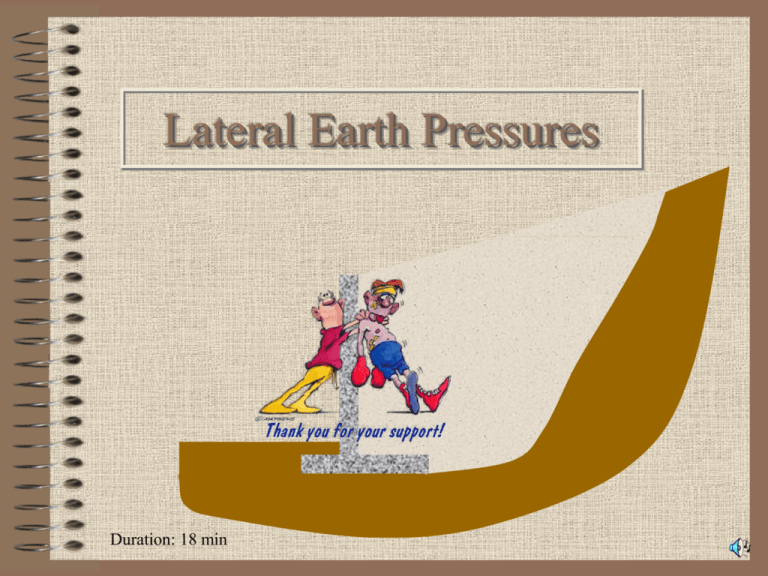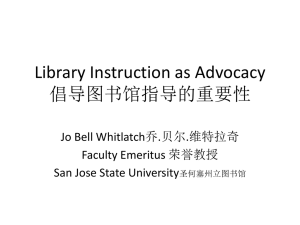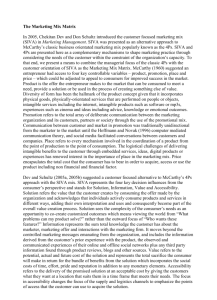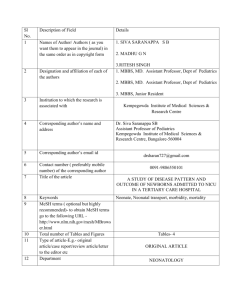SIVA
advertisement

Lateral Earth Pressures
Duration: 18 min
Copyright©2001
SIVA
Contents
• Geotechnical applications
• K0, active & passive states
• Rankine’s earth pressure theory
A 2-minute break
• Design of retaining walls
• A Mini Quiz
2
Copyright©2001
SIVA
Lateral Support
In geotechnical engineering, it is often necessary to
prevent lateral soil movements.
Tie rod
Anchor
Sheet pile
Cantilever
retaining wall
Braced excavation
Anchored sheet pile
3
Copyright©2001
SIVA
Lateral Support
We have to estimate the lateral soil pressures acting on
these structures, to be able to design them.
Gravity Retaining
wall
Soil nailing
Reinforced earth wall
4
Copyright©2001
SIVA
Soil Nailing
5
Copyright©2001
SIVA
Sheet Pile
Sheet piles marked for driving
6
Copyright©2001
SIVA
Sheet Pile
Sheet pile wall
7
Copyright©2001
SIVA
Sheet Pile
During installation
Sheet pile wall
8
Copyright©2001
SIVA
Lateral Support
Reinforced earth walls are increasingly becoming popular.
geosynthetics
9
Copyright©2001
SIVA
Lateral Support
Crib walls have been used in Queensland.
filled with
soil
Good drainage & allow plant growth.
Looks good.
Interlocking
stretchers
and headers
10
Copyright©2001
SIVA
Earth Pressure at Rest
In a homogeneous natural soil deposit,
GL
v’
h’
X
the ratio h’/v’ is a constant known as coefficient
of earth pressure at rest (K0).
Importantly, at K0 state, there are no lateral strains.
11
Copyright©2001
SIVA
Estimating K0
For normally consolidated clays and granular soils,
K0 = 1 – sin ’
For overconsolidated clays,
K0,overconsolidated = K0,normally consolidated OCR0.5
From elastic analysis,
K0
1
Poisson’s
ratio
12
Copyright©2001
SIVA
Active/Passive Earth Pressures
- in granular soils
Wall moves
away from soil
A
Wall moves
towards soil
B
smooth wall
Let’s look at the soil elements A and B during the
wall movement.
13
Copyright©2001
SIVA
Active Earth Pressure
- in granular soils
v’ = z
v’ z
h’
A
Initially, there is no lateral movement.
h’ = K0 v’ = K0 z
As the wall moves away from the soil,
v’ remains the same; and
h’ decreases till failure occurs.
Active state
14
Copyright©2001
SIVA
Active Earth Pressure
- in granular soils
As the wall moves away from the soil,
Initially (K0 state)
Failure (Active state)
v ’
active earth
pressure
decreasing h’
15
Copyright©2001
SIVA
Active Earth Pressure
- in granular soils
WJM Rankine
(1820-1872)
[h’]active
v’
[ h ' ]active K A v '
1 sin
KA
tan 2 (45 / 2)
1 sin
Rankine’s coefficient of
active earth pressure
16
Copyright©2001
SIVA
Active Earth Pressure
- in granular soils
Failure plane is at
45 + /2 to horizontal
v’
h’
45 + /2
A
90+
[h’]active
v’
17
Copyright©2001
SIVA
Active Earth Pressure
- in granular soils
As the wall moves away from the soil,
h’ decreases till failure occurs.
v’ z
h’
A
h’
K0 state
Active
state
wall movement
18
Copyright©2001
SIVA
Active Earth Pressure
- in cohesive soils
Follow the same steps as
for granular soils. Only
difference is that c 0.
[ h ' ]active K A v '2c K A
Everything else the same
as for granular soils.
19
Copyright©2001
SIVA
Passive Earth Pressure
- in granular soils
Initially, soil is in K0 state.
As the wall moves towards the soil,
v’
h’
B
v’ remains the same, and
h’ increases till failure occurs.
Passive state
20
Copyright©2001
SIVA
Passive Earth Pressure
- in granular soils
As the wall moves towards the soil,
Initially (K0 state)
Failure (Active state)
passive earth
pressure
v ’
increasing h’
21
Copyright©2001
SIVA
Passive Earth Pressure
- in granular soils
v’
[h’]passive
[ h ' ] passive K P v '
1 sin
KP
tan 2 (45 / 2)
1 sin
Rankine’s coefficient of
passive earth pressure
22
Copyright©2001
SIVA
Passive Earth Pressure
- in granular soils
Failure plane is at
45 - /2 to horizontal
v’
h’
45 - /2
A
90+
v’
[h’]passive
23
Copyright©2001
SIVA
Passive Earth Pressure
- in granular soils
As the wall moves towards the soil,
h’ increases till failure occurs.
v’
h’
h’
Passive state
B
K0 state
wall movement
24
Copyright©2001
SIVA
Passive Earth Pressure
- in cohesive soils
Follow the same steps as
for granular soils. Only
difference is that c 0.
[ h ' ] passive K P v '2c K P
Everything else the same
as for granular soils.
25
SIVA
Copyright©2001
Earth Pressure Distribution
- in granular soils
[h’]active
PA and PP are the
resultant active and
passive thrusts on
the wall
[h’]passive
H
PA=0.5 KAH2
h
PP=0.5 KPh2
KPh
KAH
26
h’
Passive state
Active state
K0 state
Wall movement
(not to scale)
Copyright©2001
SIVA
Rankine’s Earth Pressure Theory
[ h ' ]active K A v '2c K A
[ h ' ] passive K P v '2c K P
Assumes smooth wall
Applicable only on vertical walls
28
Copyright©2001
SIVA
Retaining Walls - Applications
Road
Train
29
Copyright©2001
SIVA
Retaining Walls - Applications
highway
30
SIVA
Copyright©2001
Retaining Walls - Applications
High-rise building
basement wall
31
Copyright©2001
SIVA
Gravity Retaining Walls
cement mortar
plain concrete or
stone masonry
cobbles
They rely on their self weight to
support the backfill
32
Copyright©2001
SIVA
Cantilever Retaining Walls
Reinforced;
smaller section
than gravity
walls
They act like vertical cantilever,
fixed to the ground
33
Copyright©2001
SIVA
Design of Retaining Wall
- in granular soils
2
Block no.
2
3
3
1
1
toe
toe
Wi = weight of block i
Analyse the stability of this rigid body with
xi = horizontal distance of centroid of block i from toe
vertical walls (Rankine theory valid)
34
Safety against sliding along the base
Fsliding
PP {Wi }. tan
soil-concrete friction
angle 0.5 – 0.7
PA
to be greater
than 1.5
2
2
PA
H
3
3
PA
1
PP
S
toe
h PP
1
S
R
toe
y
R
y
PP= 0.5 KPh2
PA= 0.5 KAH2
Safety against overturning about toe
Foverturning
PP h / 3 {Wi xi }
PA H/3
to be greater
than 2.0
2
2
PA
H
3
3
1
PP
S
toe
h PP
R
y
1
S
toe
R
y
PA
Copyright©2001
SIVA
Points to Ponder
How does the key help in improving the stability
against sliding?
Shouldn’t we design retaining walls to resist at-rest
(than active) earth pressures since the thrust on the
wall is greater in K0 state (K0 > KA)?
37






